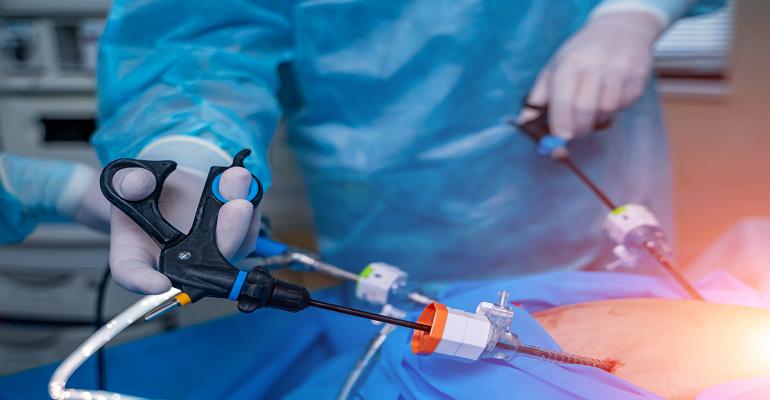Obesity is the first pandemic of the 21st century and the most serious chronic non-communicable disease facing mankind according to the World Health Organization (WHO). According to the World Obesity Federation, obesity is defined as a chronic progressive relapsing life-threatening complex neurohormonal disease. The American Medical Association defines obesity as a medical condition in which excess body fat accumulates to the extent that it may have an adverse effect on health, leading to reduced life expectancy and/or increased health problems.
In adults, it is defined by body mass index (BMI) of 30 or greater. In children and. adolescents, it is defined by a BMI for age at or above the 95th percentile of a specified reference population. BMI is calculated by dividing the weight in Kg by the squared height in meters. Figure 1 shows normal and abnormal BMI and classification of obesity.

Figure 1
Bariatric surgery is the only durable treatment for morbid obesity and its related diseases. Over the last 50 years, many surgical operations did not survive because of the safety, durability, morbidity, and mortality. Laparoscopic Roux en Y gastric bypass (LRYGB) is one of the few surgical operations that survived for more than 50 years since its discovery by the late Dr. E Maison in 1967. It is being used as a benchmark of all bariatric surgical operations.
In this operation, a small less than 50 ml pouch “gastric pouch” is created from the stomach and separated completely from the rest of the stomach. The small intestine “jejunum” is transected around 50 -100 cm from the ligament of trietz (junction between duodenum and jejunum) to create the biliary limb and then a 100 cm from the transection to create the Roux limb. Two anastomoses are created between the jejunum and the gastric pouch called gastro-jejunal anastomosis, and another one to connect the intestine together to create the jejuno-jejunal anastomosis, as shown in figure 2.

Figure 2
The mechanism that RYGB helps the patient to lose weight and put their obesity-related diseases in remission is a complex neurohormonal one. Changing the gastrointestinal signal; to the brain, pancreas, liver through endocrine, neuronal and hormonal changes. Hormonal changes like decrease Ghrelin, decrease insulin resistance, increase in Glucagon-like peptide 1 and polypeptide YY are among many hormonal changes that have been seen after RYGB.
The minimally invasive approach “being able to do this operation laparoscopically” first done by Dr Alan Wittgrove in 1993, has changed the scope of this operation as it reduced morbidity and mortality and made it more widely used across the world.
LRYGB has been studied extensively over the past 50 years. Many studies have proven the superiority of this operation to many other surgical options. It is currently being considered the “STANDARD” surgical operation to treat morbid obesity. Any new surgical operation has to match the safety profile and provide better results to gain popularity.
Type 2 diabetes mellitus (T2DM) is one of the most important obesity-related diseases. RYGB has proven its efficacy in treating it. Many international medical associations recommend considering bariatric surgery in treating T2DM patients specially when it is not optimally controlled.
The long-term effect of RYGB on T2DM has been well stablished. Ted D Adams, and his colleagues published a study in the New England Journal of medicine in 2017, in which he showed that 51 per cent of patients with T2DM who had RYGB were on no medications 12 years after the surgery.
Two recent randomized controlled trials from Sweden “SM-BOSS” and Finland “SLEEVEPASS” trials by R Peterli and B Wolnerhanssen et al, showed that, five years after the surgery, RYGB was superior to sleeve gastrectomy in weight loss, dyslipidemia and hypertension remission. Dr. P. Schauer’s study also showed superiority of RYGB over sleeve gastrectomy in treating T2DM in the famous STAMPED trials five years after the surgery.
Bariatric surgery and RYGB in specific has been proven to reduce the predicted 10-years and lifetime cardiovascular disease risk through decreasing BMI, blood lipids in males and females, according to the study that was published in the surgery for obesity and related magazine journal (SOARD) in April 2020 on more than 1170 patients by Amanda S Hinerman and colleagues.
The durability of weight loss after RYGB has been studied, and a recent study by L Angrisani on 105 patients showed that 15 years after the surgery, patients mean excess body weight loss is more than 50 per cent. In addition, 50 per cent of T2DM patients, 61 per cent of hypertensive patients and 58 per cent of dyslipidemic patients were in remission also.
The safety of bariatric surgery, in general, has been improving over the last 20 years, as shown in figure 3. RYGB safety profile has been evaluated by Kumar and his colleagues in 2018 published in SOARD, which showed 1.6 per cent morbidity and 0.2 mortality in more the 41,000 patients who had RYGB.

Figure 3
LRYGB has proven to be an effective and safe option to treat obesity, T2DM and many other obesity-related diseases over the last 53 years. It is a technically demanding operation that requires good compliance from patients with vitamins and lifestyle like most bariatric operations. Advances in surgical knowledge, training, and techniques make the surgery easier and safer with time.
Morbid obesity is a chronic relapsing disease, and it requires life-long follow-up and commitment from patients and healthcare providers to control the disease and prevent relapse.
References available on request

Dr Mohammed Al Hadad
The article was published in Arab Health Daily Dose Day 1. Read all the issues here.


